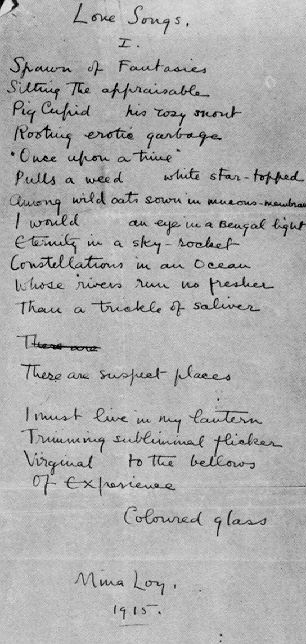Britain/United States, (1882-1966)
Love Songs
- I.
- Spawn of Fantasies
- Silting the appraisable
- Pig Cupid his rosy snout
- Rooting erotic garbage
- “Once upon a time”
- Pulls a weed white star-topped
- Among wild oats sown in mucous-membrane
- I would an eye in a Bengal light
- Eternity in a sky-rocket
- Constellations in an ocean
- Whose rivers run no fresher
- Than a trickle of saliva
- These are suspect places
- I must live in my lantern
- Trimming subliminal flicker
- Virginal to the bellows
- Of Experience
- Coloured glass
Editor’s Note:
The above is an excerpt from the controversial opening sequence of one of Loy’s most infamous poems, ‘Love Songs,’ wherein she re-figures the god of love as a swine of carnal appetite.
As a possibly further explanation, here is an excerpt from Eric Murphy Selinger writing on Loy in “Love in the Time of Melancholia” in Mina Loy: Woman and Poet, edited by Maeera Shreiber and Keith Tuma, National Poetry Foundation (1998):
“Once upon a time,” this verse suggests, we told love stories, fairy-tale romances, in which sex was kept discretely out of sight. Now Pig Cupid’s rosy snout, a displaced and comical phallus, burrows into every sub text, bringing lust to light. The results are dispiriting, at best. The “I” of the poems is not a mystified or sentimental Lady in a Garden—but she is not a free and undeceived New Woman, either, enjoying the fruits of her “fantasies” of sexual freedom. Her fantasies have yielded only a grotesque “spawn,” and the speaker herself has been transformed into a “weed” amid Pig Cupid’s crop of wild oats, “white and star-topped” but planted in an oppressively physical ground of “mucous-membrane.”
“Swill poetry,” readers called this. “Hoggerel.” They were not entirely wrong. It’s clear from the “Feminist Manifesto,” “Virgins Plus Curtains,” and other poems like “Parturition” that Loy has no nostalgia for what Whitman aptly dubbed “this tepid wash, this diluted deferential love” in which the body stayed unspoken. She, too, dreams of a poetry of “sex, womanhood, maternity, desires, lusty animations, organs, acts” in which biology would speak. But in the Love Songs she hardly finds herself a poet of “the eternal decency of the amativeness of Nature” (Whitman 1334-35).
An image of Love Songs #1 as handwritten by Loy in 1915 is shown below:

About the Poet
Mina Loy (1882-1966), original name Mina Gertrude Lowy, British modernist poet. Loy was a self-exiled ‘citizen of the world,’ and became a naturalized US citizen in 1946. Her first published poems appeared in the US in 1915 in a style that involved the elimination of punctuation marks, a collage-like method of line spacing and a disregard for regulation grammar and syntax.
Loy quickly gained a reputation as one of the most avant of the avant-garde and a poet whose strongly feminist work portrayed the intimate aspects of female sexuality and emotional life. While primarily remembered for her poetry, Loy was also a painter, fashion designer, maker of toys, a lamp shade designer and she constructed collages from garbage and found objects. [DES-6/03]

From one of her finest works. I’m not sure if it’s in the “Selected,” but it’s certainly in “The Lunar Baedeker,” edited by Roger Conover, published by Jonathan Williams’ Jargon Press. I taught her for years as the swift alternative between the Pound/Eliot futurist conservatory and the psychedelic radical dadaist workers of now. but even as critics essayed her work, there was never a reprint of her Baedeker for my students to buy. Roger, who also edited the “Selected,” told me that he left out the longer poems because they wouldn’t fit in the Penguin (?) book. Then why doesn’t Roger’s own MIT publish it? She’s essential to Am Po, feminists, cybernauts, astronomers, etc. Mystery! With the eye on and in things that WCWilliams, who was smitten by her, practiced, and Loy’s wit and abandon, they’d make a hell of a dancing crit on the grave of industrial (or industrious) modernism.
Andrei Codrescu
Thanks for your insights, Andrei. I did not know about WCWilliams interest. That would have been an outstanding combo! A shame Pig Cupid never united them.